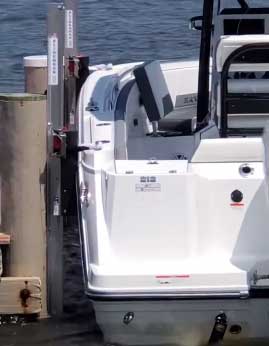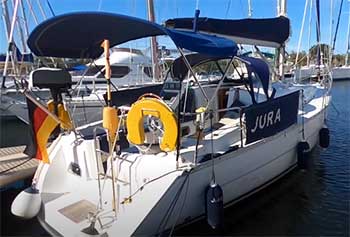Anchoring your beloved boat should be as smooth as the sea breeze, whether you’re navigating through choppy waters or easing into a serene bay. Today, we’re diving deep into two popular boat docking systems: TideSlide and SlideMoor.
We’ll unearth their key features, and weigh up the pros and cons of each system.
So, let’s set sail!
A Brief Comparison Table
| Features | TideSlide | SlideMoor |
| Motion Accommodation | Vertical | Vertical & Lateral |
| Installation | Easy, DIY | More Complex, May require professional help |
| Maintenance | Virtually None | Regular check-ups & occasional replacements |
| Material | Stainless Steel | Marine-grade Aluminum & Stainless Steel |
| Pricing | Pricier | More Affordable |
| Security | Adjusts with tide and wave action | 24/7 Security, regardless of tide changes |
TideSlide: A Wave of Innovation
A brainchild of the marine experts at PSI Marine, TideSlide has rapidly made a name for itself in the boat docking realm. Let’s explore why.
Features of TideSlide

TideSlide employs a patented vertical motion system, allowing boats to ride the tides and waves while securely moored.
Its solid stainless steel shaft ensures durability against the roughest weather.
What’s more, TideSlide uses its Dynamic Loading technology to protect your boat from the damage often inflicted by traditional mooring systems.
Advantages of TideSlide
- Unparalleled Safety
Safety is TideSlide’s biggest selling point. The system adjusts with the tide and wave action, reducing the risk of your boat breaking free or becoming damaged.
- Easy Installation
With a straightforward installation process, TideSlide is a breeze to set up. All you need is a standard dock pile.
- No Maintenance
Thanks to its corrosion-resistant construction, TideSlide requires virtually no maintenance, saving you both time and money.
Drawbacks of TideSlide
While TideSlide has many strong points, it’s not without its cons.
- Price
TideSlide systems tend to be on the pricier side, which might be off-putting for some boat owners.
- Limited Flexibility
TideSlide is great for vertical motion but offers limited flexibility for lateral movement, which could be an issue in some weather conditions.
Also Read: Differences Between Dock Blocks And Jet Dock.
SlideMoor: Slide into Ease
SlideMoor is another heavy hitter in the docking system market, renowned for its simplicity and effectiveness.
Features of SlideMoor
SlideMoor operates on a simple “slide” principle, utilizing a two-point system that secures your boat tightly to the dock, eliminating the need for multiple lines.
The system accommodates water level changes and boat movement while ensuring your boat remains close to the dock.
Advantages of SlideMoor
- Simplified Docking

With SlideMoor, docking becomes a breeze.
Its simple design eliminates the need for constant line adjustments, reducing the anxiety associated with traditional docking.
- 24/7 Security
SlideMoor ensures your boat stays snugly against the dock, regardless of tide changes or wave activity. It’s like having a 24/7 security guard for your boat.
- Durability
Made with marine-grade aluminum and stainless steel, SlideMoor is built to withstand the test of time and tide.
Drawbacks of SlideMoor
SlideMoor is a fantastic solution, but it’s not without its shortcomings.
- Installation Complexity
Compared to TideSlide, SlideMoor is slightly more complex to install, often requiring professional help.
- Needs Regular Maintenance
SlideMoor components can be susceptible to wear and tear, requiring regular check-ups and occasional part replacements.
Key Differences Between TideSlide and SlideMoor
When it comes to choosing the right boat docking system, understanding the differences between the available options is paramount. TideSlide and SlideMoor, while both excellent choices, cater to slightly different needs and conditions. Let’s delve into their key differences.
- Motion Accommodation
TideSlide shines with its patented vertical motion system. The design allows your boat to move up and down with waves and tides, minimizing the risk of damage.
It adjusts itself according to the water’s movements, providing superior protection against the wear and tear that can come from prolonged exposure to the elements.
SlideMoor, on the other hand, provides a two-point mooring that keeps your boat tightly secured to the dock, accommodating both vertical and lateral movements.
It stands strong against tide changes and wave activity, ensuring your boat stays snugly against the dock. It essentially provides a more comprehensive range of motion, making it an ideal choice for environments with substantial water movement.
- Installation Process
TideSlide takes the cake when it comes to ease of installation. It’s designed to work with a standard dock pile, making the installation process simple and straightforward. Even without prior experience, boat owners should have little difficulty setting it up.
SlideMoor, however, may require professional installation. Its design, while effective, is slightly more complex and might need a more skilled hand for proper setup. While this isn’t a major setback, it could mean additional costs and time.
- Maintenance
In terms of maintenance, TideSlide has the upper hand. It’s built with a corrosion-resistant stainless steel shaft, which requires virtually no maintenance. This can save boat owners time and money in the long run.
SlideMoor, while durable, may require occasional check-ups and part replacements. Regular maintenance is recommended to ensure it stays in top shape and continues to offer reliable protection for your boat.
- Pricing
In general, TideSlide tends to be pricier than SlideMoor. Its superior materials and patented design make it a more premium choice. However, considering its minimal maintenance requirements, it could prove a worthwhile investment.
SlideMoor, being slightly more affordable, may appeal more to budget-conscious boat owners. However, it’s worth considering that potential maintenance costs could add up over time.
Also Read: Effective Mooring Whip Substitutes.
Frequently Asked Questions (FAQ)
A slip refers to a specific space between two piers or docks where a boat is tied, offering protection on three sides. Moorage, on the other hand, is a broader term encompassing all kinds of boat storage options, including slips, buoys, and docks.
You simply attach your boat’s mooring lines to the TideSlide system, which moves up and down a piling as the water level changes. It’s designed to provide a stable, secure hold, minimizing stress on the lines.
Wet mooring refers to a boat being stored in the water, usually tied to a fixed or floating dock, a buoy, or a secure structure. Wet moorings are generally used for boats that are regularly taken out on the water.
Sailboat mooring involves securing a sailboat to a permanent structure or a weighty object on the seabed, using a rope, cable, or chain. The mooring system should allow the sailboat to swing around the mooring point, adapting to changes in wind and current.
Final Thoughts
When it comes to choosing between TideSlide and SlideMoor boat docking systems, it’s a matter of personal preference and specific needs. Both systems are robust and reliable, offering great protection for your boat.
Ultimately, your choice depends on your budget, the complexity of the waterway, and your need for lateral movement flexibility.
Happy sailing!

